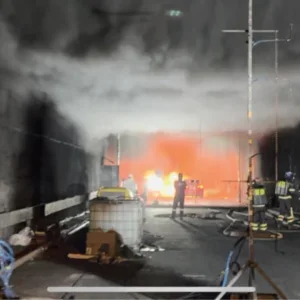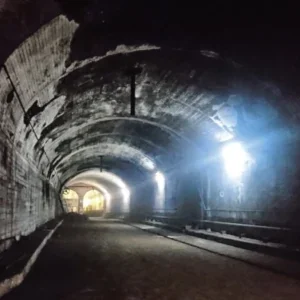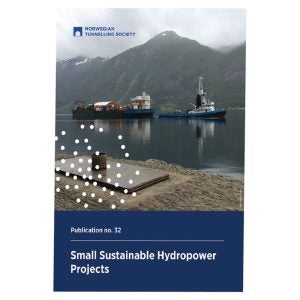Residents of the beautiful mountain lakeside town of Ioannina and students at its famous university are impatient for completion of the Egnatia highway. They know the 680km east to west sweep across northern Greece will revitalise once isolated and often poor regions. But they must wait. Even though construction is reaching a peak, much of the western sector will open only in late 2003. Some critical links will take until 2006.
The dual two-lane motorway, cutting through mountains at altitudes up to 1200m, will not only transform Greek villages but will have a significant impact on Balkan and trans-European trade.
History and funding
The Greek government had built some 121km of the road in various sections by 1994. But increased European funding led it to form a special company to speed and coordinate the project, Egnatia Odos. A key pressure was to ‘absorb’ money from the second Community Support Fund (CSF); some 1.23bn Euros (Dr400bn or $1bn) was available until 2000 but only if allocated to projects.
Though government owned – there is one shareholder – the company is more flexible than a ministry. In particular, it could engage an international project management firm, Brown & Root.
The initial plan was to get most of the 680km route designed, and the western part largely built during the second CSF period. Many of the tunnels and large viaducts fall in this part of the road, which passes through the Pindos Mountains.
In practice, work has proved complicated, says Sergios Lambropoulos the company’s general manager. “Forecasts were not the result of a detailed engineering analysis,” he says. “It takes longer.”
Detailed design and construction has brought unforeseen problems; in particular one area of the mountains is home to some of Europe’s few remaining brown bears and protective legal action has held up work for a 40km length of the road. Archaeology has also created delays. Turn any ground in Greece and you could hit relics and there are plenty along the line of this road.
Not for nothing is it named Egnatia, the Roman name for an ancient route the empire built here 2,000 years ago. Parts of the old pavement are still visible.
The European Union has agreed to extend the scheme as a ‘bridging project’, running into CSF Three from 2000-2006. Sums will be greater than before, says Lambropoulos, totalling Dr700bn ($1.84 bn) with up to seven years to use it.
Design and management
Egnatia Odos was created in late 1995 and began operating early in 1996, says Lambropoulos “with two computers, two secretaries and a new project manager”. The idea was to forge a new organisation drawn from the Greek private and public sectors and international project management experience “as a team fusing capacities”, he emphasises.
Integration has been critical, underlines Guy Hindley, the first project manager, now project director. Even though Brown & Root is an international firm, he says, making the whole work as a mixture of Greek and international experience has been vital.
“Starting from scratch did, however, allow the company to set up a suite of procedures and control systems we could then tailor to the Greek situation,” he says. Document and finance control systems were established and software standardised.
Existing design work was piecemeal. “People were working in different boxes all over Greece,” says Hindley, “and often to different standards, DIN or American or British. Sometimes even the road width would be different.”
Over 18 months, Egnatia created new guidelines for its design firms, known as OSMEO. “These were based on international best practice though incorporating work done by the Ministry earlier.”
New quality control procedures were brought in and designs also amended to fit a second design framework specifically on the environment, known as OSAT. This restricts portal sizes for example, as part of landscaping principles to minimise the highway’s impact.
The changes have helped create a uniform set of specifications across most of the Egnatia projects, and beyond. Chief design manager Christos Georganopoulos is currently sitting on two government committees revising the Greek specifications for highways and the legal framework for design.
The new organisation has also modified the traditional Greek bidding system, in which contractors offer a discount on a reference price calculated from the initial outline design. Contracts are then detail design and build.
Egnatia uses a consultant’s design. “The contractor is allowed to offer alternatives but it has not happened in most cases,” says Hindley, who is urging moves towards an international contract form.
Most tunnels are being built by an ‘active’ support method using varying levels of elements such as rock bolts, forepoles and steel sets interacting with the rock mass. Selecting the correct support requires continuous observation and design intervention, and one recent management change has led to continuing active participation of tunnel designers during construction.
Georganopoulos argues that the designer is best placed to modify the design according to rock mass category or unexpected conditions.
Egnatia has used the construction manager for such decisions. Three international consortia of consultants have roles as construction managers on the project, one for each sector — east, west and central. They keep staff on site at contract locations.
“They will be assisted now by a designer’s representative during excavation and application of primary support,” explains Georganopoulos. “It has taken time to get this accepted,” he says, “but now it will happen for seven of the most difficult tunnels.”
Guidance at the other tunnels will remain with the construction managers and advice from Egnatia whose tunnel team, headed by Nikolaos Kazilis and his alternate Colin Rawlings, monitors contracts.
Tunnels
Most tunnels are excavated by drill and blast or, in a few cases, by excavator or roadheader. A few tunnels currently under construction are by cut and cover. Future use of TBMs has not been ruled out, although a horseshoe shaped cross-section is standard.
Conditions on projects range from relatively straightforward to extremely difficult. One tunnel suffers from repeated falls due to karstic solution features infilled with terra rossa and rock fragments; another is in highly shattered rock; others change ground type every 20m and squeezing ground is expected in one project to come. Use of forepoling is frequent.
In the mountains, access is often difficult and many sites have begun by constructing several kilometres of haul road. Winters can be severe here, though this year has been exceptionally mild.
Geology
The complex geology of northern Greece would probably rule against dedicated machine drives. Rock is mixed and highly variable ranging from marbles to limestone, so shattered it contains pockets of rock flour. One of two specialist consultants used by the project, Professor Paul Marinos of the Athens Technical University, describes it as a melange. Together with Dr Evert Hoek of Canada, he makes regular visits and both are highly regarded by contractors and designers.
The whole area has been subject to major tectonic influences, from the formation of the Alps onwards, explains Kazilis. Although not as seismic as southern Greece, the region is still shaken regularly, which is a further reason for choosing tunnels rather than bridges.
“The region’s geology also changes dramatically,” explains Kazilis, “because it comprises a series of overthrust layers.” Rock masses in the same formation show “dramatically different geotechnical parameters,” says Professor Paul Marinos, “even within the same civil engineering construction.”
From the west coast at Igoumenitsa to the Metsovitikos river is the Ionian ‘layer’ with flysch and alternations of carbonate formations, plus a limited occurrence of schist.
From there to Metsovo are the Pindos mountains, with mainly flysch of various types, intensely folded and heavily sheared “drastically degrading the quality of the rock”, according to Marinos.
The next region, as far as Panagia, is called the ‘Nappe of Pindos ophiolites’. But while predominant, the ophiolites are very heterogeneous in weathering and shear characteristics. Some weak flysch is also found.
Onwards from Panagia to Siatista, the region becomes one of molasses, comprising alternating thick bedded conglomerates sandstones and marls, and in general these are relatively undisturbed with less tectonic shearing.
Next is the Pelagonian tectonic unit extending as far as Lefkoptera and showing much harder rock such as marbles, gneisses and granites, with some local fault weakening.
A longer section in the hills towards Veria has phyllites, limestones and ophiolites with overthrusting and shearing.
From Veria onwards is the rich agricultural area on the flat flood plains towards Thessaloniki, comprising mainly recent and unconsolidated alluvial fill. Some was marsh or shallow sea as little as a century ago.
A final long tectonic region stretches east of Thessaloniki to the Turkish border and here are two massifs, the Serb-Macedonian and the Rhodope, both showing a ‘basement of hard crystalline marbles gneisses and granites’. These are weathered in places and crossed locally by faults.
The highway route also crosses marls and sandstones and some recent deposits with a loose structure. Though primarily at grade or on bridge, this region does have at least six tunnels.
Paramithia
Furthest west, contractor Serantopoulos is in joint venture with Italian firm Astaldi for the Dr29bn ($75.6M), 10km section through a valley close to the small town of Paramithia. Originally planned with a series of bridges on the north side, this was changed because of severe slope instability, says Nikos Kazilis. There are now five bridges and two tunnels, one 480m long and one 1,100m.
This latter has its own problems, however, passing through a limestone that is so heavily shattered that in places it is rock flour. “It is a peculiar material with varying blocks and a high degree of interlocking,” explains Kazilis, “but it can suddenly lose all strength and just flows.”
“Sometimes even just applying shotcrete can excavate the face,” says the contractor’s production engineer, Noell Power.
The only effective method has been forepoling, he says, and the contractor is using an Italian Puntel machine to push an umbrella of 114mm diameter rods forward some 12m to form the crown for the top heading. Like most of the Egnatia tunnels, this one uses a top heading followed by a single bench.
The rods are at 300mm centres and there is a 4m overlap along the length. “We also use grouting because we don’t want to rely purely on the static umbrella effect,” says Power.
A Liebherr 932 tunnel excavator does the excavation, and shotcrete is applied to the face and wall with a Normet machine. A Cat 966 loads Mercedes trucks for spoil disposal.
Progress is “metre by metre”, says Power and it is necessary to probe ahead though “it is hard to assess the rock” which changes every 3m to 4m.
The first part of the 110m or so that both faces have progressed was through loose scree and the excavation is now emerging into the limestone proper. Later in the drive gypsum is expected with possible swelling ground.
Dodoni
Limestone with very different properties makes the 3,300m long Dodoni an unusual tunnel. The material is karstic and riddled with varying size infilled solution cavities which have led to several falls, two through to the surface 80m above.
The tunnel is sited west of the town of Ioannina and work began in March 1999 by a joint venture of Aktor (one of Greece’s most experienced tunnel firms), Avax and Eteth. The designer is Malios & Associates.
Currently the joint venture is working only from the eastern portal though a second drive is under preparation at a new portal and a short length of road cutting.
At the first site the contractor used grouted forepoling to get through an initial 64m of clay using a Casagrande PG11125. The main bores started in August.
Perhaps uniquely on the Egnatia, this was a full face operation for the 9.5m high tunnel which Aktor mining engineer Elias Katsivelis enthuses about. “Full face allows you to drive nearly twice as fast,” he says, “perhaps 90m in the time it would take to do 120m of top heading.”*
“Plant is more efficient and mucking much easier, and the ventilation especially is better.” With fumes rising to the top of the tunnel, crews can get back to the face much faster, he says.
The contractor is using mainly Tamrock machines for drilling and mucking. Two three-boom Super semi-automatic machines were bought specially while an older three boom Maximatic is used for spiling and rock bolting. A Toro loader with 6m³ capacity fills a pair of Toro T40 dumptrucks at each face for the drive to a disposal area 500m from the tunnel. Mercedes trucks are also used.
The blast pattern is 400mm short of profile with the remainder scaled out. “A most useful machine is the Liebherr 932 which we use for scaling and lifting arches,” says Katsivelis. Support in one of four classes is mainly rockbolting done by an H513 machine and steel arches.
Despite good production of 12m a day on each of two faces, Kazilis worries about the slow-up that a serious face instability might cause. So far, Aktor has not had a major face problem, but it has had troubles in the roof. Just a few metres into the main tunnel there was a collapse with 1,800m3 of ‘flowing ground’ comprising wet argillaceous material which had filled a large solution cavity. Days later, the second drive saw a similar problem when 1,200m³ of material flowed in, running through an 8m diameter hole to the surface 80m above.
These initial problems were solved by part grouting the void and using forepoling to span the gap. Curiously Katsivelis says ground is usually very good after a void.
The early falls led to development with the contractor’s designers (this contract is design and build) to create a special support system. Assessment to one of four categories is the result of probe drilling with three holes up to 22m ahead.
For small unstable pockets in the crown, 5m dowel spiles help hold the rock blocks in place, with anchors in the side walls and steel arches. For increasingly larger potential problems the drive switches to one of three increasingly heavy forepoling options over larger angles of the crown from 90° to 130°. Rock bolts and steel arches support the rest. Spacing of the 12m-long forepoling is with a 4m overlap and the centres are as little as 200mm in the heaviest category.
Katsivelis thinks the problems are easing as the overburden increases above 150m and suspects that towards the other end of the tunnel the rock will become more blocky. “It is younger and less faulted.” This will help the new drives due to begin.
Driskos
One of the longest tunnels, Driskos, brings the road through two bores down from the Pindos mountain valleys into the plain around Ioannina, just where the flysches make a transition to limestone and overlying terra rossa.
Four-firm joint venture Elliniki Technodomiki (Themeliodori, Pandehniki and Efelidis with Aktor as a tunnelling subcontractor) began the work in May 1999 and has been doing well on the tunnel. It hopes to finish the 4574m twin bore on schedule in May 2003, working currently from four faces.
There are two 50m high, 8m diameter, ventilation shafts to construct and cross passages every 400m. “They were originally quite small at 30m²,” says Kazilis, “but at every kilometre one in three has been widened to allow vehicles to pass through.” The change follows recent tunnel fire tragedies.
Problems here are more to do with access and the tunnel length than difficulties in the rock. The Ionian flysch, whose thin layers of sandstones and siltstones cause problems in areas of intense shearing, leads to some overbreak.
“There has been a little convergence,” says Prassas Nikos of the joint venture. Support has mainly been in the upper three of five categories. Some 0.6kg /m³ of gelignite suffices for the blasting in rounds 1m to 1.6m long; the rock varies from 80MPa unconfined compressive strength for the sandstone to 5-20MPa in the siltstone.
Nikos’ main concern, he says, has been to establish good teamwork and communication by the support groups. On a long tunnel, he says, thinking ahead is important, to help the face crews.
Currently the western sides are more than 1,700m in on the top heading and the drives from the east at 1,250m and 700m, respectively, where the need to form a 6.5km access road meant a later start.
The tunnel uses Tamrock equipment mainly, new three boom jumbos for the faces and Robos for the general drilling rock bolting. Three Putzmeister 110 units are used for shotcreting. Two Toro 010s and two Cat 950Gs do the loading into a total six Toro 050 dumptrucks and eight Mercedes trucks. River gravel is brought in to form a temporary haul road.
A five to six hour cycle is needed in the Category 3 rock, says Ioannis Ioannou, a geologist for the site construction manager. Seven hours is needed for the next and 10 hours in the upper support category. Two shifts of ten hours are worked.
Benching is likely to begin in June and the permanent lining for the tunnel should start following on in September, using CIFA tunnel forms.
Dio Korython
Dio Koryphon, or Twin Peaks tunnel, is one of five tunnels alternating with 80m high viaducts to form a dramatic 6km section of the project higher in the mountains, the north Metsovo alignment. Four of these tunnels were realigned from the south side of the valley where highly unstable landslips required an excessive level of drainage, says Kazilis.
Marinos described how competent limestone overthrust onto flysch leads to high cliffs with screes covering the softer flysch. Water percolates and degrades rock, leading to slides and earthflows. Falling limestone blocks complicate matters.
“We cannot say the flysch is a difficult rock,” says Babis Issaias, a civil engineer with contractor Mochlos and general manager of the consortium Mechaniki/Mochlos/Athina/Avax. “Difficulties here are due more to the steep slopes (up to 60°) on which we form the portals and the tight spaces in the mountains for operations.” The first winter after the contractor signed the Dr63bn ($165M) contract in October 1999 was typical with heavy snow.
The joint venture also has to worry about foundations for a 10 span incrementally launched bridge, and a balanced cantilever bridge with a 230m middle span and piers up to 80m high. The road leaps from bridge to tunnel and this will pose some lighting problems.
Tunnels east to west are: the Kalamion at 840m, Krimnou at 1,070m, Dio Korython at 735m and Votonosi at 500m long. Work has begun on all. One final tunnel, the Anthochori, is through more difficult ground on the far side of the valley and the 110m of progress so far has been made mainly by forepoling. “Ground there needs very heavy support and the use of temporary inverts,” says Kazilis.
Many more tunnels are under construction in the central region and a half dozen in the east. Almost half are under design, particularly for the still-delayed section of the project in the central west area.
Egnatia is concentrating on town by-passes and key eastern links at present. Some 96km of road opened in 2000 and another 81km this year.
The project should be complete in 2006.
Related Files
Geotechnical units along the Egnatia highway (only):
Funding sources for the Egnatia highway project (December 2000)
Detail map of The Egnatia highway
Location Map
Absorption of funding by the project






